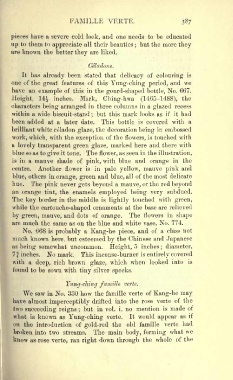Page 313 - Chinese Porcelain Vol II, Galland
P. 313
FAMILLE VERTE. 387
pieces have a severe cold look, and one needs to be educated
up to them to appreciate all their beauties ; but the more they
are known the better are liked.
they
Celadons.
It has been stated that of is
already delicacy colouring
one of the features of this and we
great Yung-ching period,
have an of this in the
example gourd-shaped bottle, No. 667.
Height, 14i inches. Mark, Ching-hwa (1465-1488), the
characters in three columns in a recess
being arranged glazed
within a wide biscuit-stand ; but this mark looks as if it had
been added at a later date. This bottle is covered with a
brilliant white celadon the decoration in embossed
glaze, being
work, which, with the exception of the flowers, is touched with
a marked here and there with
lovely transparent green glaze,
blue so as to it tone. The flower, as seen in the illustration,
give
is in a mauve shade of with blue and in the
pink, orange
centre. Another flower is in mauve and
pale yellow, pink
blue, others in orange, green and blue, all of the most delicate
hue. The pink never gets beyond a mauve, or the red beyond
an orange tint, the enamels employed being very subdued.
The touched with
key border in the middle is lightly green,
while the ornaments at the base are relieved
cartouche-shaped
by green, mauve, and dots of orange. The flowers in shape
are much the same as on the blue and white vase, No. 774.
No. 668 is probably a Kang-he piece, and of a class not
much known here, but esteemed the Chinese and
by Japanese
as somewhat uncommon. 5 inches ; diameter,
being Height,
7| inches. No mark. This incense-burner is entirely covered
with a rich brown which when looked into is
deep, glaze,
found to be sown with silver
tiny specks.
Yung-ching famille verte.
We saw in No. 330 how the famille verte of Kang-he may
have almost drifted into the rose verte of the
imperceptibly
two succeeding reigns ; but in vol. i. no mention is made of
what is known as verte. It would as if
Yung-ching appear
on the introduction of the old famille verte had
gold-red
broken into two streams. The main body, forming what we
know as rose verte, ran right down through the whole of the

